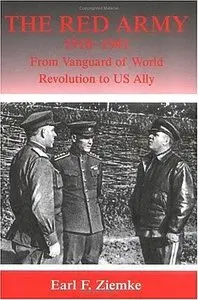Earl F Ziemke, "The Red Army, 1918-1941: From Vanguard of World Revolution to US Ally"
2004 | pages: 455 | ISBN: 0714655511 | PDF | 10,3 mb
2004 | pages: 455 | ISBN: 0714655511 | PDF | 10,3 mb
Supported in large part by evidence released after the collapse of the Soviet Union, this book follows the career of the Red Army from its birth in 1918 as the designated vanguard of world revolution to its affiliation in 1941 with 'the citadel of capitalism', the United States. Effectiveness of leadership and military doctrine are particular concerns here, and Josef Stalin is the dominant personality.
On the basis of the Russian Civil War (1918-20), the Red Army began to bill itself as 'an army of a new type', inherently superior to all others. However, in late 1920, the Poles trounce it soundly. Later, Soviet intervention in the Spanish Civil War (1936-39) reveals widespread obsolescence in armament and equipment. The Nazi-Soviet Pact of August 1939 gives Germany and the USSR a free hand to act against Poland. However, slack performance by the Red Army in the unopposed occupation of eastern Poland and the bungled war with Finland in the winter of 1939-40 necessitate sweeping military reforms. Germany was an enemy in 1918, ally in the 1920s, enemy again in 1933, ally again in 1939, and the enemy once more in 1941, following the German invasion on 22 June 1941. This brings on a catastrophe that by the year's end has consumed nearly the entire pre-invasion Red Army. The United States' entry into the war on 7 December 1941 and the Red Army's subsequent recovery raise the question: Who won the Second World War?
My Links



